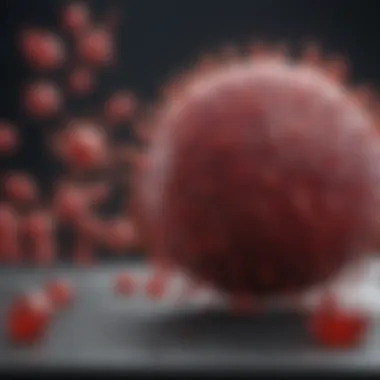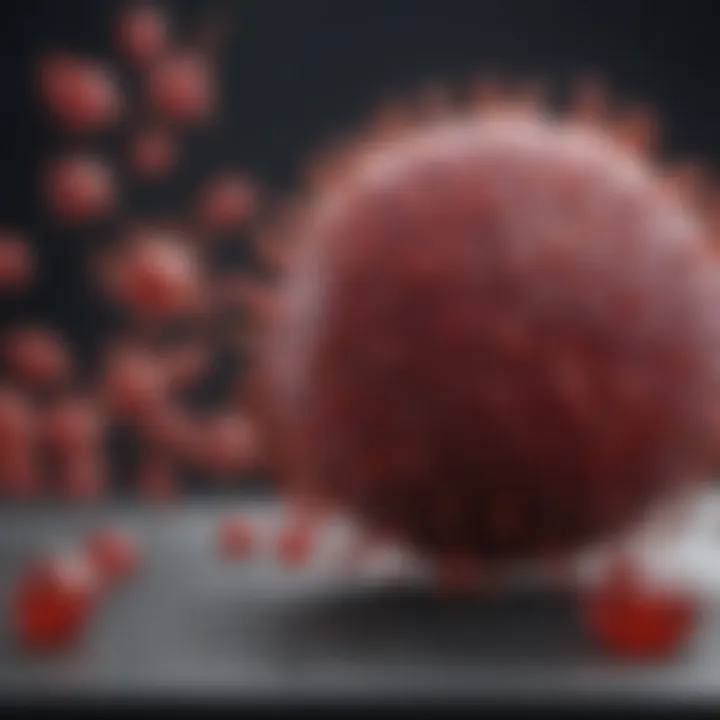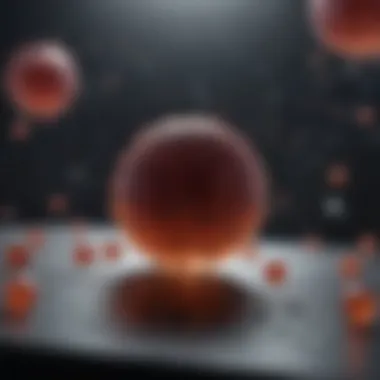T Cell Therapy for Multiple Myeloma: Advances & Impact


Intro
The treatment for multiple myeloma has seen significant evolution in recent years. T cell therapy, a type of immunotherapy that harnesses the body’s immune system, is at the forefront of this change. This article delves into the advancements in T cell treatment for multiple myeloma, providing insights into how this therapy works and its growing importance in medical practice. As this field continues to mature, understanding both the mechanisms and implications of T cell therapy becomes critical for patients, researchers, and healthcare professionals alike.
Research Overview
Key Findings
Recent studies have shown promising results with T cell therapies like CAR T-cell therapy and T cell receptor (TCR) therapy. These treatments have demonstrated potential advantages over traditional chemotherapy and stem cell transplantation, leading to improved survival rates in certain patient populations. While results can vary, many patients report significant reductions in their myeloma burden.
Study Methodology
Research in this area typically involves clinical trials to evaluate the effectiveness and safety of T cell therapies. Notable methodologies include:
- Randomized controlled trials that compare new therapies against standard treatments.
- Longitudinal studies observing treatment outcomes over extended periods.
- Case studies focusing on individual patient responses to T cell therapies.
Background and Context
Historical Background
The landscape of multiple myeloma treatment has traditionally relied on chemotherapeutic agents and radiotherapy. The understanding of immunological approaches gained traction in the late 20th century, marking the beginning of a new chapter. T cell therapies emerged as innovative options that modify a patient’s T cells to better attack cancer cells. This advancement reflects a paradigm shift towards personalized medicine in oncology.
Current Trends in the Field
With advancements in genetic engineering and vaccine development, the field has seen a surge in research focusing on T cell therapies:
- CAR T-cell therapy: This method genetically modifies a patient’s T cells to express a chimeric antigen receptor, enabling them to better recognize and destroy malignant cells.
- TCR therapy: This approach enhances T cells’ ability to recognize specific cancer-associated antigens, leading to targeted destruction of myeloma cells.
Ongoing research continues to explore the combination of T cell therapies with existing treatments, seeking synergistic effects that enhance efficacy.
Closure
As the field of T cell treatment for multiple myeloma continues to evolve, it is imperative to stay informed about the latest findings and their implications on patient care. The advancements not only offer hope for better treatment outcomes but also underscore the importance of ongoing research and clinical trials in this vital area of healthcare.
Understanding Multiple Myeloma
Multiple myeloma is a complex hematologic malignancy that necessitates a thorough understanding for effective management and innovative treatment approaches. This section seeks to underpin the key principles surrounding multiple myeloma, highlighting its significance in the context of T cell therapies.
Definition and Classification
Multiple myeloma, often abbreviated as MM, is a cancer originating in plasma cells, a type of white blood cell responsible for producing antibodies. As these cells begin to multiply uncontrollably, they disrupt normal blood cell production and cause various health issues. The World Health Organization classifies multiple myeloma based on genetic mutations, clinical features, and diagnostic markers, including light chain disease and smoldering myeloma. This classification aids in determining prognosis and tailoring treatment plans.
Epidemiology
The epidemiology of multiple myeloma reflects a growing concern within the medical community, as it indicates increased incidence rates globally. Epidemiological studies show that MM primarily affects older adults, with a median age at diagnosis around 70 years. It is more prevalent among African Americans than Caucasians. Understanding these patterns is crucial for developing targeted screening strategies and for allocating resources effectively in the fight against this malignancy.
Pathophysiology
The pathophysiology of multiple myeloma is intricate and involves multiple steps. The disease arises from the malignant transformation of plasma cells, leading to excessive production of monoclonal immunoglobulins which can cause organ damage, particularly to bones and kidneys. The microenvironment surrounding these malignant cells plays an essential role, as it influences their growth and survival. Factors like cytokines and bone marrow stromal cells are pivotal, leading to an enhanced understanding of tumor behavior and revealing new avenues for therapeutic intervention.
Understanding the underlying mechanisms of multiple myeloma not only sheds light on the disease itself but also highlights potential therapeutic targets, paving the way for advancements in T cell therapies and other treatment modalities.
This section serves as a foundation for exploring the innovative T cell treatments designed to combat the complexities of multiple myeloma.
The Immune System and Cancer
The interaction between the immune system and cancer is a complex and crucial area of study. A comprehensive understanding of this relationship is vital for advancing treatments like T cell therapy for multiple myeloma. The immune system plays a key role in identifying and eliminating malignant cells. However, cancers often develop mechanisms to evade this immune surveillance. Therefore, exploring how T cells function within this context can shed light on the potential benefits and limitations of T cell treatments in multiple myeloma.
Overview of T Cells
T cells are a subset of lymphocytes that are integral to the adaptive immune response. They originate in the bone marrow and mature in the thymus, where they undergo a selection process to ensure they can differentiate between self and non-self. There are different types of T cells, including CD4+ helper T cells, which assist in orchestrating the immune response, and CD8+ cytotoxic T cells, which are responsible for directly killing infected or tumor cells. The diverse roles T cells play in immune regulation are crucial in understanding their application in cancer therapies.
T cell activation occurs through a series of intricate signaling pathways. When T cells recognize specific antigens presented by major histocompatibility complex (MHC) molecules on the surface of tumor cells, they can activate and proliferate. This activation is a fundamental step in developing effective immunotherapy strategies.
Role of T Cells in Cancer Immunity
In the context of cancer, T cells have both protective and paradoxical roles. They can recognize and target cancer cells effectively; however, tumors can exploit various strategies to inhibit T cell activity.
- Elimination of Tumor Cells: Cytotoxic T cells can recognize tumor-associated antigens and initiate apoptosis in cancer cells. This is crucial for controlling tumor growth.
- Immune Evasion: Tumors may express certain ligands that bind to inhibitory receptors on T cells. This interaction can diminish T cell activity, allowing the tumor to grow and spread.
- Immune Regulation: Certain types of T cells, like regulatory T cells, may suppress the immune response. While this is beneficial for preventing autoimmunity, it can be detrimental in the case of cancer.
"T cells serve as both warriors and regulators in the fight against cancer, highlighting the need for balance in immune responses."
Overall, understanding the dual roles of T cells in cancer immunity is essential. It informs the development of therapies that can either enhance T cell activity against tumors or modify the tumor microenvironment to favor a more robust immune response. The implications for treatments such as CAR T cell therapy are significant, as these therapies aim to leverage the potency of T cells while mitigating the challenges posed by tumor-induced immune suppression.
T Cell Therapy Types
T cell therapy represents a significant advancement in the treatment of multiple myeloma, a hematologic cancer characterized by the proliferation of abnormal plasma cells. T cell therapies leverage the body's immune system to target and eliminate cancer cells more effectively than traditional treatments. In this section, we explore three primary types of T cell therapies: CAR T cell therapy, T cell receptor therapy, and engineered T cell therapies. Understanding these modalities is crucial for comprehending their mechanisms and clinical implications.
CAR T Cell Therapy


CAR T cell therapy has emerged as a groundbreaking approach in immunotherapy, especially for blood cancers like multiple myeloma. CAR stands for chimeric antigen receptor. In this therapy, T cells are extracted from a patient and modified in the laboratory to express a receptor that specifically recognizes and binds to specific proteins on the surface of myeloma cells.
Once these CAR T cells are reinfused into the patient's bloodstream, they expand and target myeloma cells aggressively, initiating a potent immune response. Clinical studies have demonstrated that CAR T cell therapy can lead to durable remissions in some patients with advanced multiple myeloma, offering hope in previously untreatable cases.
The personalized nature of this therapy means that it can be tailored to the unique characteristics of a patient's disease, enhancing its effectiveness. However, it also introduces challenges, such as the potential for severe side effects like cytokine release syndrome. This necessitates careful monitoring and management following treatment.
T Cell Receptor Therapy
T cell receptor therapy is another innovative approach utilizing modified T cells to treat multiple myeloma. Unlike CAR T cells, this therapy focuses on the use of naturally occurring T cell receptors to identify cancer cells. T cells are engineered to express receptors that can recognize specific antigens presented by myeloma cells.
The advantage of T cell receptor therapy lies in its ability to target a broader variety of antigens compared to CAR T cell therapy. This is particularly significant because multiple myeloma cells often exhibit diverse antigenic profiles. The ability to simultaneously target multiple antigens may enhance treatment efficacy and minimize the risk of disease relapse. However, optimizing the selection of appropriate T cell receptors for engineering remains a complex scientific challenge.
Engineered T Cell Therapies
Engineered T cell therapies encompass a variety of strategies aimed at enhancing T cell function against cancer. This category includes both CAR and T cell receptor therapies, as well as other innovative techniques such as T cell exhaustion reversal and the use of checkpoint inhibitors alongside T cell activation.
A notable development in this area is the application of genetics to improve T cell persistence and efficacy. Researchers are engineering T cells not only to better recognize cancer cells but also to resist common forms of evasion that tumors may employ, such as downregulating immune signals. These advancements enhance the likelihood of achieving sustained anti-tumor responses in patients.
In summary, the evolution of T cell therapies, from CAR T cells to engineered options, highlights a paradigm shift in cancer treatment. Each approach offers distinct advantages and challenges that need thorough evaluation through ongoing research and clinical trials. As our understanding of these therapies grows, so too does the promise they hold for patients battling multiple myeloma.
Mechanism of Action
The mechanism of action of T cell therapy in multiple myeloma represents a pivotal area of focus in understanding how these innovative treatments function. Comprehending these processes is essential for researchers, clinicians, and patients alike, as it provides insights into the potential effectiveness and scope of T cell therapies in combating this disease. By exploring the specific interactions between T cells and myeloma cells, one can appreciate the tailored nature of these therapies and the advantages they hold over conventional methods.
Targeting Myeloma Cells
The direct targeting of myeloma cells is a fundamental component of T cell therapy. Myeloma is characterized by the uncontrolled growth of plasma cells, leading to a series of detrimental health effects. T cell therapies, such as CAR T cell therapy, utilize genetically modified T cells to recognize and attack these malignant cells specifically.
When T cells are engineered, they can express chimeric antigen receptors (CARs) that bind to unique proteins found on the surface of myeloma cells. This targeted approach enhances the precision of treatment, limiting damage to healthy cells. The identification and selection of these targets are crucial, as they dictate treatment efficacy and safety. By ensuring that T cells are directed at antigens specific to myeloma cells, researchers can improve success rates in eradicating this cancer. Furthermore, ongoing research seeks to discover additional targets on myeloma cells to expand the treatment's reach and effectiveness.
Activation of T Cells
Activation of T cells is vital for their functionality in treating multiple myeloma. After targeting myeloma cells, T cell activation determines how effectively these immune cells can proliferate and execute their cytotoxic functions. Upon recognition of their target, T cells undergo a complex activation process involving co-stimulatory signals and cytokine interactions.
Once activated, T cells multiply and differentiate into effector T cells, which are primed to kill myeloma cells. This activation is supported by various co-stimulatory receptors on T cells that enhance their response. Additionally, the tumor microenvironment, characterized by immunosuppressive factors, can inhibit T cell activation, thereby reducing therapeutic efficacy. Researchers are currently investigating how to overcome these barriers to ensure robust T cell activation.
Clinical Efficacy
In the realm of T cell treatment for multiple myeloma, clinical efficacy stands as a key measure of success. Understanding how well these treatments work is crucial for both clinicians and patients. This section delves into various aspects of clinical efficacy, including durability of response and comparative effectiveness. Each of these elements plays a significant role in evaluating how these innovative therapies improve patient outcomes in an evolving treatment landscape.
Durability of Response
The durability of response reflects how long a patient benefits from T cell therapies after initial treatment. This aspect is critical because some therapies may show immediate effectiveness, but the longevity of that effect can significantly impact overall survival rates. Research indicates that CAR T cell therapy exhibits promising durability for many patients with multiple myeloma. Reports show that a substantial percentage of patients retain their responses for extended periods, sometimes exceeding one year.
However, it's essential to consider that not all patients will have the same experience. Factors such as tumor burden, genetic markers, and prior treatment history influence how long the responses last. Data from clinical trials indicate that persistent responses can lead to deeper remissions, which in turn contribute to improved quality of life.
"Understanding the durability of response is not just about numbers; it's about enhancing life quality and extending time for patients concerned with future treatment choices."
In addition, ongoing research aims to identify biomarkers that can predict which patients are likely to have longer and more durable responses. This knowledge may allow clinicians to tailor therapies more effectively, leading to personalized treatment approaches.
Comparative Effectiveness
In comparing the effectiveness of T cell therapies to traditional treatments, a nuanced metric is required. Multiple myeloma has typically been treated with chemotherapy, immunomodulatory drugs, and proteasome inhibitors. While these treatments have provided relief for many, their effectiveness can wane, and responses may not last. T cell therapies, particularly engineered options, have emerged as potent alternatives that often surpass the outcomes of conventional methods.
Clinical trials have shown that CAR T cell therapy can lead to higher rates of complete response compared to older treatments. Factors such as improved minimal residual disease (MRD) negativity are particularly notable. Patients achieving MRD negativity are generally associated with better long-term outcomes, reinforcing the importance of comparing these therapies against the backdrop of traditional options.
- Higher Response Rates: Studies reveal that T cell therapies achieve higher complete response rates.
- Improved Survival Outcomes: Results indicate potential improvements in progression-free survival compared to conventional therapies.
Despite these promising outcomes, comparative effectiveness studies must factor in patients' diverse biological makeups and treatment histories. Ongoing research endeavors seek to explore the interactions between prior therapies and the efficacy of T cell treatments, paving the way for evidence-based recommendations tailored to individual patient needs.
These two elements, durability of response and comparative effectiveness, form the backbone of understanding clinical efficacy in T cell treatments for multiple myeloma. As research continues to evolve, the implications for patient care and treatment strategies will become clearer, ultimately enhancing therapeutic success.
Side Effects and Management
The management of side effects stemming from T cell treatment for multiple myeloma is crucial. Understanding these adverse effects can significantly inform treatment decisions and improve patient quality of life. It is essential for both healthcare providers and patients to be aware of potential complications that can arise during and after therapy. Moreover, proactive management can mitigate some of the risks associated with these treatments.
Common Adverse Effects
Adverse effects associated with T cell therapies can range from mild to severe. Some common side effects include:
- Cytokine Release Syndrome (CRS): This condition occurs when T cells release a large amount of cytokines into the bloodstream. Symptoms can include fever, fatigue, and nausea.
- Neurological Toxicities: Patients may experience confusion, seizures, or other cognitive difficulties following treatment. It is critical to monitor these symptoms closely.
- Infections: Since T cell therapies can affect the immune system, there is an increased risk of infections, particularly during the early weeks of treatment.
- Graft-Versus-Host Disease (GVHD): In cases where donor T cells are used, there is a risk of these cells attacking the recipient's tissues, which can lead to severe complications.
The recognition of these common side effects aids in patient management and supports timely interventions when complications arise. Understanding the mechanisms and expected timeline for these effects can better prepare both providers and patients.
Strategies for Management
Effective management strategies are necessary to deal with the side effects of T cell treatments. Here are some methods to alleviate adverse effects:
- Monitoring and Early Intervention: Regular assessments can help identify side effects quickly. This can include blood tests to monitor cytokine levels, vital signs, and neurological assessments.
- Symptomatic Treatment: Addressing symptoms as they arise is essential. For example, anti-inflammatory medications can be used to manage CRS symptoms. Other medications may help in controlling infections.
- Patient Education: Educating patients about what to expect can improve their coping strategies. They should be informed about potential side effects and encouraged to report any symptoms immediately.
- Multidisciplinary Care: Involving various healthcare professionals can enhance care quality. This includes oncologists, nurses, and pharmacists, all working together to develop individualized management plans.


"Timely recognition and management of side effects can significantly enhance the patient experience and treatment outcomes."
Current Clinical Trials
The exploration of T cell treatment for multiple myeloma is significantly advanced through ongoing clinical trials. These trials are crucial for understanding the efficacy and safety of new therapies. As research progresses, clinical trials serve as the backbone for translating laboratory findings into practical treatments for patients. They help establish not only the viability of a therapy but also identify optimal patient populations, assess long-term outcomes, and monitor potential adverse effects.
Understanding the current landscape of clinical trials is imperative. It provides essential insights into how far the science has come in fighting multiple myeloma and what challenges remain. Patients have the opportunity to participate in trials, which can provide access to cutting-edge therapies. Additionally, these trials often contribute to a better understanding of the disease itself, yielding information that could lead to even more effective treatments in the future.
Among the reasons for the importance of current clinical trials, the following stand out:
- Innovative Therapies: Trials are providing novel treatment protocols that could outperform existing therapies.
- Patient Stratification: Understanding who benefits most, allowing for more tailored treatment approaches.
- Improved Outcomes: Continuous monitoring of survival rates and quality of life indicators through clinical data.
"Clinical trials represent the bridge between laboratory research and patient care, ensuring that new treatments are both safe and effective."
Key Ongoing Studies
Several prominent studies are underway that focus on T cell therapies for multiple myeloma. These studies are pivotal as they evaluate different approaches and combinations of T cell treatments. Some of the notable ongoing trials include:
- CAR T Cell Trials: Research assessing the efficacy of CAR T therapies, such as those utilizing bb2121 (idecabtagene vicleucel). These trials are examining the safety and effectiveness of autologous CAR T cells, specifically looking at deep and durable responses in relapsed multiple myeloma patients.
- T Cell Receptor Studies: Trials exploring engineered T cell receptor therapies, such as the study of NY-ESO-1 specific T cells. These studies assess how well engineered T cells can target myeloma cells.
- Combination Therapies: Research combining T cell therapy with traditional treatments like lenalidomide or bortezomib, aiming for a synergistic effect that enhances overall efficacy.
The results from these trials could reshape treatment paradigms, leading to improved patient outcomes and setting new standards in the management of multiple myeloma.
Promising Preliminary Results
Preliminary results from these trials are beginning to emerge, showing promising efficacy rates and tolerable side effects. Some findings from key studies include:
- High Response Rates: Early reports indicate that CAR T cell therapy can achieve a high overall response rate in heavily pre-treated multiple myeloma patients, with some trials observing complete remission in a significant percentage of participants.
- Duration of Response: Initial findings suggest that the effects of T cell therapies may last longer compared to traditional treatments. This could be crucial for patients who have limited options after multiple lines of chemotherapy.
- Tolerability: Although side effects exist, many trials report that the new therapies are tolerable, allowing patients to maintain a quality life while undergoing treatment.
The ongoing data collection will be key to further validating these results. As trials progress, the hope is that they solidify a position for T cell therapies at the forefront of treatment options for multiple myeloma.
Personalized Medicine
Personalized medicine has become integral in the treatment landscape for multiple myeloma, particularly with the emergence of T cell therapies. It emphasizes customization of healthcare, tailoring treatment strategies to individual patient characteristics, including their genetic makeup and disease profile. This approach is essential in oncology due to the heterogeneous nature of cancers and the variances in patient responses to standard therapies.
By focusing on the specific traits of a patient's cancer, personalized medicine aims to enhance the efficacy of treatments while minimizing unnecessary side effects. For instance, T cell therapies like CAR T cell therapy can be adjusted to target unique antigens present on the myeloma cells of a particular patient. As a result, there is a higher likelihood of achieving a positive therapeutic outcome.
A key benefit of personalized medicine is the development of an enriched understanding of disease mechanisms at the molecular level. This understanding can lead to the identification of biomarkers useful for diagnosis, prognosis, and treatment selection. By implementing these strategies, healthcare providers can make more informed decisions, ultimately improving survival rates and patient quality of life.
However, personalized medicine also poses challenges. It demands extensive research and validation to ensure that treatment plans based on individual characteristics are indeed more effective than traditional approaches. Furthermore, variability in treatment access, financial burdens, and the necessity for comprehensive data collection can complicate the adoption of personalized methods in routine clinical practice.
"Personalized medicine offers a pathway toward precision in treating multiple myeloma, ensuring that patients receive therapies suited to their unique tumor characteristics."
Tailoring Treatment Approaches
Tailoring treatment approaches in personalized medicine involves analyzing a patient's unique medical history, genetic profile, and specific tumor biology. This process starts with comprehensive genomic profiling of the myeloma cells to identify mutations, alterations, and drug targets. Various techniques, such as next-generation sequencing, enable clinicians to gather detailed information on the molecular landscape of the patient's cancer.
Once the necessary data is obtained, oncologists can design a treatment regimen that integrates T cell therapies with other modalities. For instance, using CAR T cell therapy, the engineered T cells can be directed against specific antigens that may vary between patients. Dual therapies combining traditional chemotherapy or immunomodulatory drugs with T cell therapy may also be considered based on the patient's overall health and disease stage.
Additionally, this tailored approach requires continuous assessment and modification of the treatment plan based on the patient’s response. Regular monitoring through imaging studies and laboratory tests helps in determining treatment efficacy and making adjustments as needed. This dynamic strategy showcases a shift from the traditional 'one-size-fits-all' model to more individual-centric care, enabling better management of multiple myeloma.
Biomarkers in Treatment Selection
Biomarkers play an essential role in the realm of personalized medicine for multiple myeloma. They are measurable indicators found in blood, tissues, or other bodily fluids that can provide critical insight into the biology of the cancer and its response to treatment. Understanding which biomarkers are present in a patient can guide clinicians in selecting the most appropriate therapies.
Several types of biomarkers are currently under investigation, such as genetic mutations, protein expressions, and other novel targetable pathways associated with T cell responses. For example, the presence of certain mutations may indicate sensitivity to specific T cell therapies. This knowledge allows for precision in treatment selection, aligning drug mechanisms with the unique characteristics of the patient's cancer.
Moreover, the identification of predictive biomarkers can aid in understanding potential resistance mechanisms to T cell therapies. By identifying these markers upfront, oncologists can develop strategic plans to overcome or bypass resistance, potentially improving patient outcomes.
In summary, the integration of personalized medicine, through tailored treatment approaches and effective use of biomarkers, holds great promise for enhancing T cell therapy efficacy for multiple myeloma patients. This evolution seeks not just to treat the disease but to understand it fundamentally—transforming how cancer care is delivered.
Future Directions in T Cell Therapy
Advancements in T cell therapy for multiple myeloma have opened new avenues for treatment and research. This section will explore future directions, focusing on novel therapeutic agents and integrative approaches. As scientists gain a better understanding of myeloma biology and T cell functionality, the potential benefits of these advancements become clear.
Novel Therapeutic Agents
Development of novel therapeutic agents is a key area of interest in T cell therapy. Researchers are emphasizing the importance of designing drugs that enhance T cell performance while minimizing adverse effects. Some promising agents include:
- Bispecific T cell engagers (BiTEs): These molecules can bind to both T cells and myeloma cells, promoting T cell activation and cytotoxicity directly at the tumor site.
- Check-point inhibitors: These agents help to reactivate exhausted T cells, allowing them to function more effectively against myeloma cells.
- Cytokine therapies: By modulating the immune microenvironment, cytokines can boost T cell activity and proliferation.
Integrating these agents into treatments could lead to improved outcomes for patients. However, research into optimal dosing and timing is necessary to refine combinations that will yield the best therapeutic response.
Integrative Approaches
Integrative approaches represent another promising future direction for T cell therapy. This involves combining T cell treatments with other therapeutic modalities to enhance effectiveness. Strategies may include:
- Combination therapies: Using T cell therapies alongside traditional chemotherapy or monoclonal antibodies can provide synergistic effects, potentially leading to improved efficacy.
- Personalized treatment plans: Tailoring immunotherapy based on individual genetic profiles and tumor characteristics can optimize patient responses.
- Adjuvant therapies: Including agents that modulate the tumor microenvironment might help support T cell activity against myeloma.
The convergence of these different treatment strategies could lead to comprehensive management approaches for multiple myeloma. Researchers continue to explore these integrative pathways, as they provide a broader framework for understanding how to combat this malignancy effectively.


"Future directions in T cell therapy offer valuable insights into improving outcomes for patients with multiple myeloma through innovative and integrative strategies."
Regulatory and Ethical Considerations
The field of T cell therapies for multiple myeloma is rapidly evolving, bringing significant advancements in patient care. However, it also raises critical questions regarding regulatory and ethical aspects. These considerations are vital not only for ensuring patient safety but also for the overall integrity of medical practices. In this section, we discuss the frameworks governing the approval of new therapies, and the importance of informed consent in maintaining patient autonomy. Each element intertwines with the treatment process, showcasing the need for stringent guidelines and ethical standards.
Approval Processes for New Therapies
Introducing a new treatment into clinical practice involves rigorous regulatory processes. T cell therapies for multiple myeloma must undergo a thorough evaluation to ensure their safety and efficacy. The U.S. Food and Drug Administration (FDA) plays a crucial role in this evaluation. Researchers are required to submit Investigational New Drug (IND) applications before initiating clinical trials. This application outlines the therapy’s composition, manufacturing process, and the preliminary results from lab studies.
Once clinical trials commence, they typically progress through several phases:
- Phase 1 trials focus on safety and dosage, assessing how the therapy affects the human body.
- Phase 2 trials evaluate efficacy and further monitor safety in a larger group of patients.
- Phase 3 trials involve comparison against standard treatments, involving an even larger population to confirm effectiveness and monitor side effects.
- After successful completion of these phases, the therapy can be submitted for FDA approval.
The importance of this structured process cannot be overstated. The intention is clear: protect patients from ineffective or harmful treatments while providing a pathway for innovative therapies to enter the market.
Informed Consent and Patient Autonomy
Informed consent is a cornerstone of ethical medical practice. It is particularly relevant in the context of T cell therapies for multiple myeloma. As these treatments emerge and evolve, patients must be fully educated about their options. This encompasses understanding the potential benefits, the nature of the treatment, risks involved, and alternative therapies that may be available.
Patients should be informed about:
- The experimental nature of T cell therapies.
- Potential side effects and long-term impacts, which may not yet be fully understood.
- The possibility of adverse reactions or lack of response to therapy.
- Participation in clinical trials and its implications.
By ensuring patients receive comprehensive information, they can make choices that align with their values and preferences. This promotes autonomy, enhancing trust in the patient-provider relationship. Informed consent is not merely a formality; it embodies respect for individuals as capable decision-makers.
"Informed consent is not just a signature on a document, it is a process that ensures patient autonomy and fosters a collaborative approach to treatment."
Challenges in Implementation
The implementation of T cell therapy for multiple myeloma presents a series of challenges that are crucial to understand. These challenges can influence treatment accessibility, efficacy, and overall patient outcomes. As advancements in this sector continue, a comprehensive approach to tackle these obstacles is necessary to ensure that innovative therapies reach the patients who need them most.
Access to Treatment
Access to appropriate T cell therapies remains a significant challenge. Different factors contribute to this limitation. Geographical location plays a crucial role. In many regions, specialized treatment centers equipped to provide T cell therapies are sparse. Such location disparities create barriers for patients who live far away from these healthcare institutions, potentially delaying treatment or leading to abandoned care plans.
Economic factors also play an important part. Not all healthcare systems cover the costs associated with cutting-edge treatments. Many patients may find that their insurance does not fully cover CAR T cell therapy or other engineered T cell therapies. Consequently, the financial burden falls on them, leading to inequity in treatment access across socioeconomic classes.
Availability of clinical trials represents another dimension of this challenge. Clinical trials are essential for testing new therapies, but they are often limited in scope and reach. Patients might not have nearby trials to participate in, which can hinder their access to potentially life-saving treatments.
"Ensuring equitable access to T cell therapy is essential for maximizing its potential benefits for all patients."
Cost and Economic Burdens
The cost associated with T cell therapy is a daunting economic burden for many patients and healthcare systems worldwide. The expenses related to manufacturing, monitoring, and administration of these specialized treatments are significant. CAR T cell therapy, for example, can cost upwards of several hundred thousand dollars. This financial reality increasingly places patients in difficult positions.
Healthcare systems also feel the strain. The introduction of high-cost therapies forces many institutions to reassess their budgets and resources. Hospitals may have to allocate significant funds towards these advanced therapies, creating pressure on their overall financial health. This can lead to a ripple effect where services related to more traditional forms of treatment suffer.
Moreover, there is a concern about the sustainability of T cell therapies in the long run. As the number of patients needing treatment increases, there will be an ever-growing demand for resources and funding. Without strategic planning and resource allocation, the sustainability of such therapies may come into question.
Ultimately, as these challenges are navigated, innovative solutions must be developed to bridge the gap between the promising biology of T cell therapies and their real-world implementation in the healthcare landscape.
Global Perspectives
In the rapidly evolving field of T cell therapy for multiple myeloma, understanding global perspectives is vital. This aspect encompasses various factors such as treatment accessibility, regulatory frameworks, and research collaboration across countries. Examining these elements provides a broader context for the advancements made in T cell treatments and their implications for patients around the world.
As multiple myeloma can affect individuals differently based on their geographical and socio-economic backgrounds, variations in treatment access are a glaring reality. Some regions may benefit from cutting-edge immunotherapies, whereas others may struggle with basic treatment options. This disparity often stems from differing healthcare systems, availability of resources, and economic constraints.
It is crucial for stakeholders in this field to address these inequalities. Achieving equitable treatment access not only improves patient outcomes but also fosters a sense of global solidarity among healthcare providers, researchers, and patients. By promoting discussions and collaborations on international platforms, the medical community can share knowledge and strategies to enhance treatment accessibility across different nations.
"Global perspectives on T cell therapy can catalyze efforts to eliminate disparities in treatment access and outcomes across various populations."
Variations in Treatment Access
Access to T cell therapies for multiple myeloma varies markedly around the globe. In developed countries, patients might have access to advanced treatments such as CAR T cell therapy. In contrast, patients in low-income regions may not only lack access to these novel therapies but also struggle with outdated treatment protocols. This inequality raises significant ethical concerns, as the benefits of personalized medicine and cutting-edge therapy should be available to all, regardless of location. Some of the critical factors influencing treatment access are:
- Healthcare Infrastructure: Well-established healthcare systems can provide the framework for the implementation of complex therapies like T cell treatments.
- Regulatory Approvals: Different countries have varying speeds in approving new therapies. The regulatory landscape can delay or hasten patient access to clinical innovations.
- Economic Factors: Countries with robust health insurance systems generally facilitate better access to advanced therapies, while those lacking such support face stark challenges.
Investment in healthcare infrastructure, as well as policy reforms to enhance the availability of T cell therapies, is critical for closing these gaps.
International Collaboration in Research
International collaboration in research is essential for advancing T cell therapies for multiple myeloma. Collaborative efforts can lead to pooling of resources, intellectual expertise, and shared data, all of which contribute to accelerated findings. Research focused on diverse populations can lead to more customized T cell treatments that consider genetic variation among different ethnic groups.
Organizations and researchers are forming partnerships across borders to tackle the challenges posed by multiple myeloma. These collaborative efforts include:
- Joint Clinical Trials: Conducting trials across multiple sites can enhance the generalizability of study results, leading to more reliable findings.
- Shared Databases: Establishing common databases for tracking patient outcomes can help identify effective treatment protocols and improve care practices.
- Knowledge Exchange: Forums and symposiums provide platforms for researchers from different countries to share insights, methodologies, and outcomes.
Such collaborations may not only facilitate the rapid development of effective therapies but also aid in educating the global healthcare workforce about the complexities of myeloma treatment. Enhancing these networks can lead to significant advancements and ensure that innovations in T cell therapies benefit patients worldwide.
The End
The conclusion of this article underscores the critical advancements in T cell treatment for multiple myeloma. It emphasizes that these technologies are not only innovative but also pivotal in reshaping treatment paradigms for this complex cancer. Understanding these developments is essential for medical professionals, researchers, and students who seek to grasp the evolving landscape of cancer therapies.
In reviewing the various T cell therapies, it becomes clear that the efficacy of treatments like CAR T cell therapy and T cell receptor therapy are on the rise. Their ability to specifically target myeloma cells represents a leap forward from traditional methods. These therapies showcase promising results while striving to improve patient outcomes and diminish relapse rates.
Moreover, considerations about patient experiences and public health are paramount. By integrating these advancements into clinical practice, healthcare providers can enhance the overall management of multiple myeloma, addressing both biological and societal implications.







